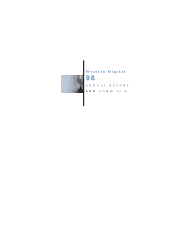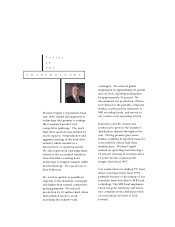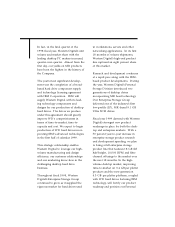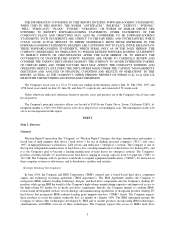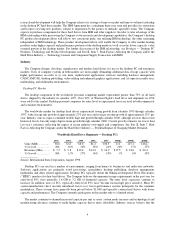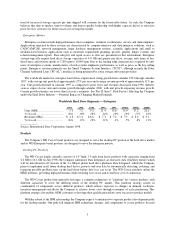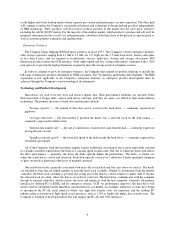Western Digital 1998 Annual Report Download - page 9
Download and view the complete annual report
Please find page 9 of the 1998 Western Digital annual report below. You can navigate through the pages in the report by either clicking on the pages listed below, or by using the keyword search tool below to find specific information within the annual report.
4
research and development will help the Company achieve its strategy of time-to-market and time-to-volume leadership
in the desktop PC hard drive market. The IBM Agreement has a minimum three-year term and provides for extensions
and licenses covering new products, subject to negotiation by the parties of mutually agreeable terms. The Company
expects to purchase components for these hard drives from IBM and other suppliers. In order to take advantage of the
IBM relationship while preserving the Company's own research and development capabilities, the Company's desktop
PC product development efforts will follow two concurrent paths, one utilizing IBM technology, the other remaining
independent of IBM technology. These product development efforts will enable the Company to offer market-leading
products in the higher capacity and performance portions of the desktop market as well as in the lower capacity, value
oriented portion of the desktop market. For further discussion of the IBM relationship, see Products — Desktop PC
Products, Technology and Product Development, and Part II, Item 7, Risk Factors Affecting the Company and/or the
Hard Drive Industry — Technology License and Component Supply Transaction with IBM.
Industry
The Company designs, develops, manufactures and markets hard drives for use in the desktop PC and enterprise
markets. Users of computer systems in both markets are increasingly demanding additional data storage capacity with
higher performance in order to (i) use more sophisticated applications software including database management,
CAD/CAM/CAE, desktop publishing, video editing and enhanced graphics applications, and (ii) operate in multi-user,
multitasking, and multimedia environments.
Desktop PC Market
The desktop component of the worldwide personal computing market represented greater than 75% of all hard
drives shipped by the industry in calendar 1997. Over 90% of Western Digital's hard drive unit shipments in 1998
were sold to this market. Desktop personal computers for entry level to experienced users are used in both commercial
and consumer environments.
The worldwide market for desktop hard drives experienced strong growth from calendar 1993 through calendar
1997, with average unit growth of approximately 27% per year and average revenue growth of approximately 23% per
year. Industry sources expect continued double digit unit growth through calendar 2000, although at lower than recent
historical levels, but only single digit revenue growth through calendar 2000. Current growth estimates are lower than
last year's estimates, reflecting the impact of recent industry oversupply and competition. See Part II, Item 7, Risk
Factors Affecting the Company and/or the Hard Drive Industry — Potential Impact of Changing Market Demands.
Worldwide Hard Drive Shipments — Desktop PCs
1993 1994 1995 1996 1997 1998E 1999E 2000E
Units (MM)................ 38.8 52.8 68.8 81.2 100.5 111 127.1 146.4
% Growth.................. N/A 36% 30% 18% 24% 10% 15% 15%
Revenues ($Bn) ......... $ 7.5 $ 9.8 $12.4 $14.4 $ 16.9 $17.5 $ 18.6 $ 20.4
% Growth.................. N/A 31% 27% 16% 18% 3% 6% 10%
____________
Source: International Data Corporation, August 1998.
Desktop PCs are used in a number of environments, ranging from homes to businesses and multi-user networks.
Software applications are primarily word processing, spreadsheet, desktop publishing, database management,
multimedia and other related applications. Desktop PCs typically utilize the Enhanced Integrated Drive Electronics
("EIDE") interface for their hard drives. The Company believes the minimum storage requirements in the past year for
entry-level PCs were generally 1.6 GB to 3.2 GB of formatted capacity. The entry level capacities continue to
increase. In addition, users of PCs, especially entry-level PCs, have become increasingly price sensitive. Many PC
system manufacturers have recently introduced lower-cost, lower-performance systems principally for the consumer
marketplace. These systems have generally been priced below $1,000 and typically contain hard drives with lower
capacity and performance. The Company currently participates in this market only to a limited extent.
The market continues to demand increased capacity per unit as users' system needs increase and technological and
manufacturing advances continue to make higher capacity drives more affordable. Industry sources believe that the

